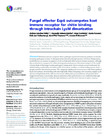Fungal effector Ecp6 outcompetes host immune receptor for chitin binding through intrachain LysM dimerization
dc.contributor.author
Sánchez-Vallet, Andrea
dc.contributor.author
Saleem-Batcha, Raspudin
dc.contributor.author
Kombrink, Anja
dc.contributor.author
Hansen, Guido
dc.contributor.author
Valkenburg, Dirk-Jan
dc.contributor.author
Thomma, Bart P.H.J.
dc.contributor.author
Mesters, Jeroen R.
dc.date.accessioned
2018-09-10T14:39:00Z
dc.date.available
2017-06-11T13:02:48Z
dc.date.available
2018-09-10T14:39:00Z
dc.date.issued
2013-07
dc.identifier.issn
2050-084X
dc.identifier.other
10.7554/eLife.00790
en_US
dc.identifier.uri
http://hdl.handle.net/20.500.11850/90721
dc.identifier.doi
10.3929/ethz-b-000090721
dc.description.abstract
While host immune receptors detect pathogen-associated molecular patterns to activate immunity, pathogens attempt to deregulate host immunity through secreted effectors. Fungi employ LysM effectors to prevent recognition of cell wall-derived chitin by host immune receptors, although the mechanism to compete for chitin binding remained unclear. Structural analysis of the LysM effector Ecp6 of the fungal tomato pathogen Cladosporium fulvum reveals a novel mechanism for chitin binding, mediated by intrachain LysM dimerization, leading to a chitin-binding groove that is deeply buried in the effector protein. This composite binding site involves two of the three LysMs of Ecp6 and mediates chitin binding with ultra-high (pM) affinity. Intriguingly, the remaining singular LysM domain of Ecp6 binds chitin with low micromolar affinity but can nevertheless still perturb chitin-triggered immunity. Conceivably, the perturbation by this LysM domain is not established through chitin sequestration but possibly through interference with the host immune receptor complex.
en_US
dc.format
application/pdf
en_US
dc.language.iso
en
en_US
dc.publisher
eLife Sciences Publications
dc.rights.uri
http://creativecommons.org/licenses/by/3.0/
dc.title
Fungal effector Ecp6 outcompetes host immune receptor for chitin binding through intrachain LysM dimerization
en_US
dc.type
Journal Article
dc.rights.license
Creative Commons Attribution 3.0 Unported
ethz.journal.title
eLife
ethz.journal.volume
2
en_US
ethz.pages.start
e00790
en_US
ethz.size
16 p.
en_US
ethz.version.deposit
publishedVersion
en_US
ethz.identifier.nebis
007613147
ethz.publication.place
Cambridge
ethz.publication.status
published
en_US
ethz.leitzahl
ETH Zürich::00002 - ETH Zürich::00012 - Lehre und Forschung::00007 - Departemente::02350 - Dep. Umweltsystemwissenschaften / Dep. of Environmental Systems Science::02720 - Institut für Integrative Biologie / Institute of Integrative Biology::03516 - McDonald, Bruce / McDonald, Bruce
en_US
ethz.leitzahl.certified
ETH Zürich::00002 - ETH Zürich::00012 - Lehre und Forschung::00007 - Departemente::02350 - Dep. Umweltsystemwissenschaften / Dep. of Environmental Systems Science::02720 - Institut für Integrative Biologie / Institute of Integrative Biology::03516 - McDonald, Bruce / McDonald, Bruce
ethz.date.deposited
2017-06-11T13:03:32Z
ethz.source
ECIT
ethz.identifier.importid
imp5936526744f2163936
ethz.ecitpid
pub:142752
ethz.eth
no
en_US
ethz.availability
Open access
en_US
ethz.rosetta.installDate
2017-07-19T11:47:05Z
ethz.rosetta.lastUpdated
2024-02-02T06:01:05Z
ethz.rosetta.versionExported
true
ethz.COinS
ctx_ver=Z39.88-2004&rft_val_fmt=info:ofi/fmt:kev:mtx:journal&rft.atitle=Fungal%20effector%20Ecp6%20outcompetes%20host%20immune%20receptor%20for%20chitin%20binding%20through%20intrachain%20LysM%20dimerization&rft.jtitle=eLife&rft.date=2013-07&rft.volume=2&rft.spage=e00790&rft.issn=2050-084X&rft.au=S%C3%A1nchez-Vallet,%20Andrea&Saleem-Batcha,%20Raspudin&Kombrink,%20Anja&Hansen,%20Guido&Valkenburg,%20Dirk-Jan&rft.genre=article&rft_id=info:doi/10.7554/eLife.00790&
Files in this item
Publication type
-
Journal Article [128858]

